
Introduction
The Romans went to naval warfare a bit late, compared to what they achieved on land. Long after they secured a vast territory within Italy and won over the Samnites (their last serious threat nearby), the Romans found themselves embroiled in a bitter conflict with the Carthaginians, by then the naval superpower of the western Mediterranean (East was dominated by the Diadochi fleets, in particular Ptolemaic Egypt).
From 264 BC onwards indeed, the Romans set foot in Sicily, for the first time outside Italy, in order to “help” Mamertines, Italic Mercenaries previously recruited by Agathocles of Syracuse and now set loose, unpaid, rampaging the countryside and capturing Messina, now asking the Carthaginian navy for help. Without going into details, the Romans allegedly captured a Carthaginian ship, and “reverse engineered” her to create their own ships they ordered in Greek shipyards in “Magna Grecia” (Apulia). They even copied apparently their prefabricated method of construction to literally spawn a massive serie of galleys. What followed was a serie of naval battles, some decisive. The lack of experience of the Romans at sea was paid by heavy losses due to the weather, but they eventually found their own way of doing naval warfare.
Not confident in pure naval tactics, including fast ramming manoeuvers, diekplous, periplous and other niceties, the Romans just trusted their infantry to do the job. They converted the sea into a land battle, but finding way to close and board enemy ships, making their own more resistant with time. One expedient was the use of a thick copper belt on the waterline to resist ramming, having bridged ships with lots of “siege weapons”, catapults and ballistae to essentially destroy rows and slow down enemy ships before introducing the famous corvus. This Roman innovation consisted in a hinged bridge swung down onto enemy vessels with a sharp spike, securing access for legionaries. This way, they had the Carthaginian repeatedly beaten at sea and won despite being newcomers in the field.
Roman naval dominance will go up the next two centuries, winning over the Carthaginians once and for all in 146 BC, and later securing the entire Mediterranean under Pompey the Great. The “Roman Lake” era really came when at the peak of the civil war, Antony and Cleopatra fleet was defeated at Actium in 31 BC. This way the last major naval power in the Mediterranean was destroyed. Until the Germanic invasions of the 3d and 4th centuries AD, this “Roman lake” ensured free and secured trade throughout the Empire, it became the center of it.
Roman Penteconter
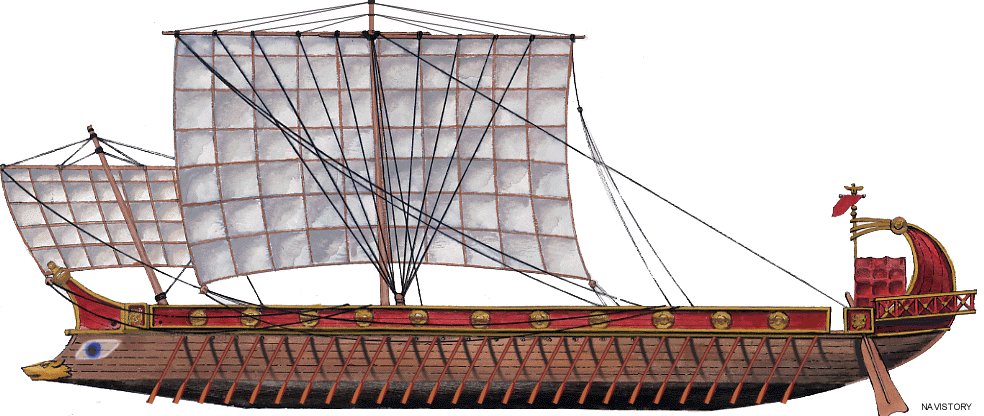
Roman Pentaconter, one of the earliest ship, here at Ostia, in 220 BC. JC.. Note the slender (Greek) lines of these light galleys, still serving as scouts before being supplanted by the liburnae of Illyrian origin.
The Penteconter is one of the oldest galleys deployed by the Romans on their own (hitherto they appealed to the Greek ships of the colonies of the south of the boot or Syracuse). Very ancient, since it dates back to the Trojan era (1500 BC), the Penteconter was “Romanized” when the latter built or commissioned it on their own account. They were not stowed, with their partial decks (only at the front and rear), and the absence of throwing weapons, raven or other standard equipment of triremes, quadriremis, and quinqueris, among the units “Offensive”, but as ships of liaison, carriers of dispatch, rapid transport, or scout, assigned role in the navies posterior to the frigate, the pinnace, or to the cruiser.
The Roman Penteconter was ranked among the “moneres” (ships with a single row of oars), constituting the top of the “naval dust” of the time. With 50 rowers in a single row, protected by a wooden bulwark, and only a few infantrymen (12 legionnaires at best), the Roman Penteconter (the name was not “romanized”), was supplanted around 50 BC. JC. By the new Liburnae inspired by Illyrian pirates, smaller, more manageable and still quick.
Roman Biremis
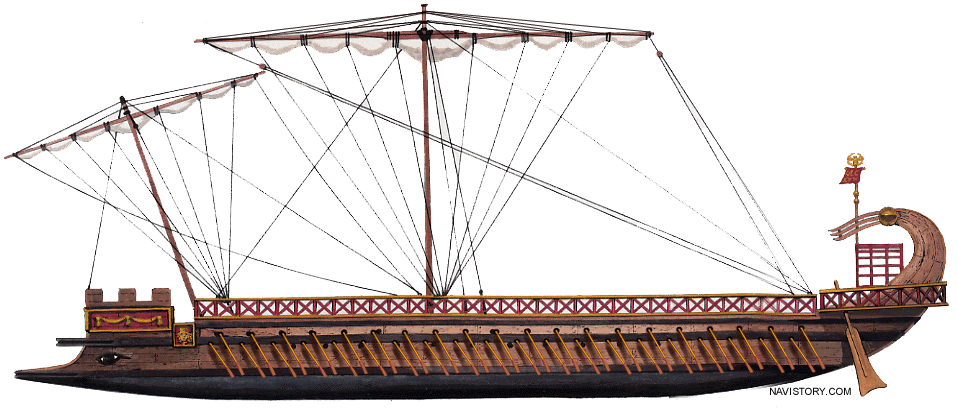
Imperial Age (50 AD). Taken from a bas-relief.
The Dikrotus was the other name of this relatively light ship (by Roman standards). It combined a more powerful driving force than the pentecontore in a reduced space precisely thanks to its staging of apostis (openings allowing the passage of the oars). Unlike the Tremes, the biremis was generally open. On the other hand, the Roman Birme was much heavier than its Greek equivalent, and that the Carthaginian ships. It is doubtful whether these vessels were dry-pitched on ramps. They were built of oak, according to the writings found, sometimes with a golden sculpture, but always with a spur (or Rostre), endowed with a small tent (La Diacta, ancestor of the “carosse”) for The shelter of his captain, the Magister Navis, a trierarch in Greek. On these light galleys (one man per oar), the troops were reduced, owing to the narrow gangway between the rowers, and their military value was diminished.
However, there is “bireme” and “bireme”. Terms may become misleading. In the “Gaul War”, Caesar succinctly describes his galley-admiral, mentioning a complete bridge, hundreds of rowers, heavy weapons (balistes and catapults embarked), not to mention the corvus – Assault, dolphins (lead spikes hoisted to yards) and two archers’ towers. Only the dimensions are unknown to us, but it seems obvious that this type of galley was a “false bireme” (although actually two rows of oars), and a real Hepter or Octer, ie both rows Of oars were to be handled by 3 or 4 men. The Biremes of this type were around 60-70 meters and embarked a cohort…
This configuration adopted by the Greeks during the Alexandrine period made it possible to devise acceptable dimensions, especially in terms of height on water, which facilitated all the more The maneuvering of the oars, heavy and long. But the biremes, at the time of the empire began to disappear in favor of moners with two rowers by oars (Liburnae, Hemioliae …) at the origin of the medieval galleys. The bireme still had good days before it, under the name of Dromon, until the fall of Constantinople.
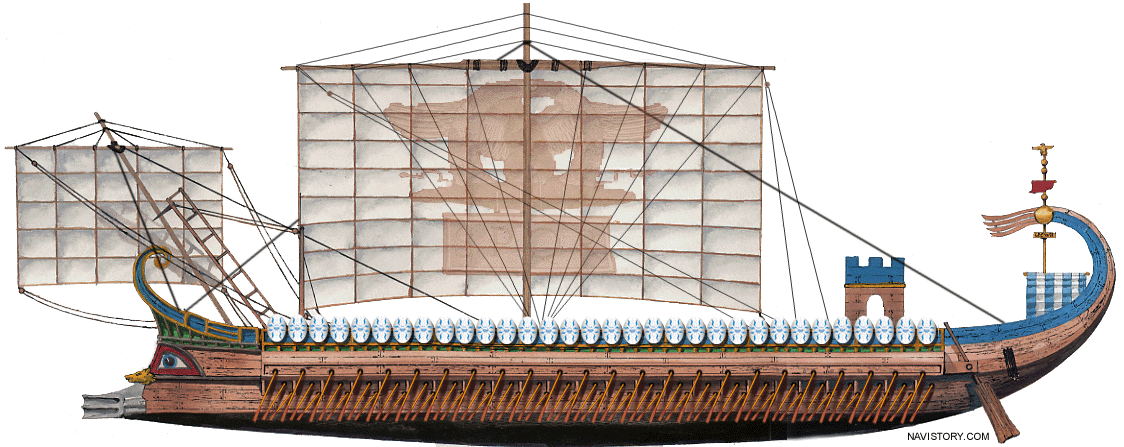
Trireme at the time of the Second Punic War. Trier properly “Roman”, built according to concepts that will be reproduced on quadrirèmes and quinquérèmes. The one represented here participated in the wars against Carthage, in the colors of Scipii (The Scipios) and the legendary Scipio the African. Apart from recurring aesthetic artifacts, such as specific prow and stern decorations, the factitious counter-rostrum at the head of the wolf (often also of wild boar or lion) one notes the rear archer’s tower and the corvus at the front , Immediate signature.
The Diere was the Greek name for this traditional, classical vessel par excellence, which ensured the domination of the Greeks and especially of Athens on the Mediterranean for centuries, until Rhodes began to innovate by creating the tetra towards 300 av. JC. The Trieme was the Roman appellation of this ship, which probably dates from the constitution of a properly Roman fleet, and not a Greek fleet of borrowings belonging to Tarentum or Messina. The first true Roman triremes were apparently built to respond to the Carthaginian threat at the time of the First Punic War (261 BC), and at the same time as the famous quinqueremes. From the outset, this ship was modified to the Roman military standards, and dedicated above all to a collision fight or the superiority of the infantry makes the difference, unlike the Greeks who still favor ramming maneuvers. This particularly affects the weight and dimensions of the trireme, clearly more massive than the frail Hellenes, which could be hoisted on the beach…
The Trieme has a complete bridge, guaranteeing more room for fighters , And possibly possesses some weapons of throw (ballistae). The rostrum is still in bronze and designed for ramming, but quickly it becomes a mere artistic extension of the hull, losing any military vocation.
Some figures: About 37-38 meters (35 for the trire) of length, 6 of width (4.2 – 5 for the trire), 170 rowers (of the lowest social classes, rarely Roman citizens), out of a total of 25 men, including the sailors, and the troop (50 men). Speed of 5-6 knots (7-8 for the trire).
There is always a Diacta (small awning for officers in stern), an archer’s tower, introduced by Agrippa on Roman ships according to some controversial sources, two permanently rigged masts and sails (never deposited for combat ). The mainsail was sometimes decorated with a supparum, while the sail of bowsprit was decorated with the name of the vessel and the insignia of its captain. The mainsail was often provided with the motif of the Republic, restored under the influence of the eagle wings spread on laurels, sometimes embellished with lightning or symmetrical motifs, and “SPQR” (Senatus Populusque Romanus). The Legion’s sign-bearing tree was found at the back, embedded in the shield of the stern figure. They were equipped since the first Punic war of “ravens”, the bridges of collision (quadriremis-quinqueremis). La Trière will continue for many years thanks to its reduced size and modest cost compared to the “4” and “5” of the fleet, but remained less useful against piracy than small units such as liburnae. Triremes were, however, engaged in all naval battles, or were involved with the Romans. It was to be renounced only at a late date, about 400 AD, in favor of large galleys with multiple swimming, but whose name remained “trireme” for a moner with three rowers by rowing, at the origin of some Byzantine ships.
Quadriremis

The naval operations during the first Punic War were decisive for the victory of the Roman arms. Even playing bad luck in losing two fleets following the disfavour of the Gods (Tempests), the Roman naval forces constituted hastily but not in the traditionally maintained imagery copied from the Greek builders or from a captured and replicated Carthaginian ship In large quantities, for Rome had for a long time maintained small fleets by means of Taranto or Syracuse, and had access long before 200 BC. J.C. has the implementation of Pentécontores, Biremes and Triemes. It was only when the new Greek standard became the “4” (Tetris) developed successfully by Rhodes and taken over by the Carthaginians (see Marsala’s ship), that the Romans in turn welcomed this type of building, Scarcely greater than the trire but having greater maneuvering force. Nevertheless, legend has it that, by capturing a Rhodian Tether serving as a fast ship to the Carthaginian fleet, the Roman Publicans had it replicated in mass and in record time to 200 copies, constituting the first fleet of Rome .
The illustration from the top here describes a four-quarters of the time of Republican Rome, about 260 BC. It is one of the very first “Tetras” Romanes, and its construction denotes Greek influences and Roman peculiarities: The stern, still complex, is clearly Greek inspiration. Thereafter, the Roman ships simplified their hull to the rear, and replaced the figure of curved stern by a simple extension of the keel, in particular to simplify the construction. The hull is high, but reinforced by porques which protrude between the aposti, and a longitudinal reinforcement short from the bow to the stern, on which a thick string comes to solidarize the stern. Six jet machines are visible, including four lateral ballista and two scorpions at the front. A raven is clearly visible at the front (the famous Roman boarding bridge), secured to the front mast.
The use of two masts with several advantages: It makes it possible to mix more easily two medium sails than a very large one, and then the masts fold more easily in the event of maneuver. It is not certain that, like the Hellenes, the Romans systematically left their masts and sails in battle. Finally, wise minds will have noticed that having two rows of oars, this galley was a bireme. In fact, the standard configuration of a Tetra was two thranites (upper bench), a zygite (middle), and only one thalamite (bottom) per shell, maneuvering three oars in three rows, such as the trire, or two Zygites and two Thalamites handling two rows of oars. It is assumed nowadays that the “4” and “5” and beyond had a maximum of three rows of oars. But nothing prohibited the construction of a two-rowed vessel with more rowing rowers, in this case three zygites and two thalamites per lane. For example, the Greek Heptera. However, most of the bas-reliefs and rare precise mosaics attest to the use of “cataphract ships” with three rows of apostis (ie oars).
Quinqueremis
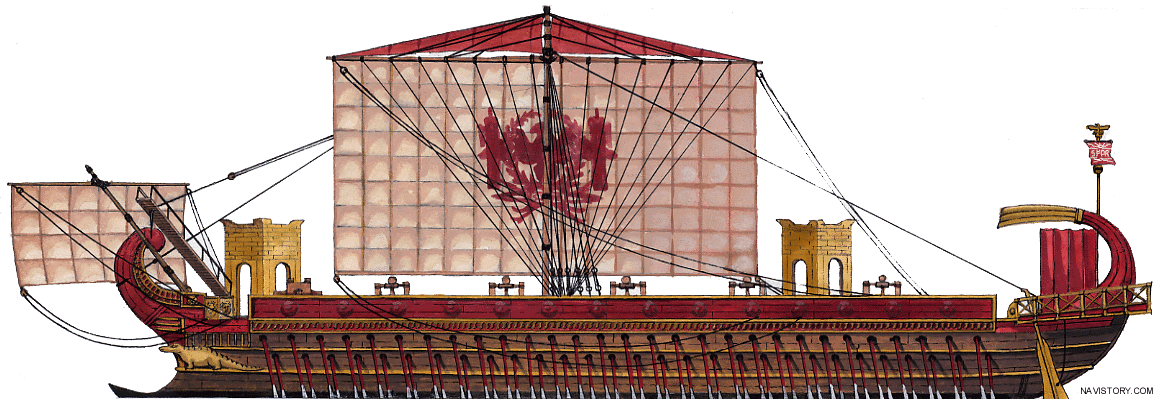
Roman Quinquereme, Imperial Rome, 68 AD
The second illustration of the bottom surprised in contrast by describing a model of heavy quinquera (a pleonasm for the Roman ships), of the fleet of Misene. The style, from the start, has changed and is becoming more Latin. One still senses the presence of Greek art in the figure of the stern, although simplified, and conceived in the prolongation of the keel, a characteristic volute at the front, which becomes an immense and pompous figure of style. One will also notice the spur in the front, raised in a beak inspired by the elements present on the fastest galleys (including the famous Rhodian Tetris). Two rounds of archers are present, although the standard is one to the rear in general.
Scorpions and catapults are visible throughout. There are no more shields fixed to the railings, but a real bulwark decorated with pseudo sculpted shields. Recurring feature on precise bas-reliefs, this quinquereme has a figurehead, the anti-rostrum, here a homage to the wars carried out in Africa by the legendary Scipio, but no painted eyes. This sacred symbol intended to guide the ship in uncertain waters has probably disappeared from the pragmatic concerns of the Roman army. The invention of the “modern” prow is there. The Byzantines later adopted a lion’s head with a flame-throwing siphon.
However, the ancient Greeks and Egyptians gave their rostres animal forms, before this instrument normalized itself as a weapon. The ramming function began to disappear on the Roman ships after the fall of the last great Hellenistic fleet, that of the Lagids. The rig consists of what is best at the time, a mainsail surmounted by a supparum, sketch of forestay sail, and a sail of bowsprit intended for the maneuvers, and to make manageable monsters constructed in Cedar. The bowsprit mast was sprinkled as well on the pentecontors as the trières and other classical galleys. This quinquereme, approximately 58 meters long and 7 meters wide, has practically the dimensions of a decree (between 60 and 80 meters). The configuration in two oars by rowing was already weak for the formidable weight of these ships which remained slow. Their weapons of throw and their troops embarked (here about 130, a fraction of cohort), make the difference. Of all the jobs of the Roman empire, that of rowing on board a galley was therefore unenviable and unwanted.
But the conscripts who found themselves there found a pay and thus escaped misery. These were provincials from less favored regions in general, who after 26 years of service could claim Roman citizenship and its advantages. His swim was composed of three zygites and two thalamites per side. They may have been standing. Under the swim compartment, completely closed and probably smelly and suffocating, there was a hold sufficiently high for a man to stand upright. There was ballast in the form of stones or lead, but also considerable water supplies in the form of stretched leather waistcoats, jars filled with dried meat and dried fruit, as the Roman fleets were sometimes more Long at sea, especially in “punitive cruises” such as those carried out during the imperial era against piracy and its many bases scattered in the eastern Mediterranean. Rigging became more important, serving more often to spare the health of rowers, whose strength was tested during warfare maneuvers only. It is now commonly accepted that masts were never laid down.
As far as the Greek trire was sufficiently airy and light to dry, the reinforced Roman trireme at the full deck was much heavier but still lacked power. With one or two extra rowers per side, the problem seemed resolved. Quinqueremes were ordered to the nearby Greek cities, then replicated and adapted, and engaged en masse during the first Punic War. This new standard developed by the Greek Cities and the great Hellenistic empires (Macedonians, Lagids, Seleucids, etc.), but also the Carthaginians, was the Pentery, which the pragmatic Romans adapted, notably to counteract lighter Carthaginian ships and They concentrated on the construction of Quinqueremes.
The latter, although more expensive to build, maneuvering more powerfully but less swiftly, had above all a formidable arsenal of balisters, scorpions and catapults, intended in particular to destroy the oars of the opposing galleys, but also more room for other, Advantage of troops, including the famous heavy Romaine infantry, soldiers trained on the ground and summarily adapted, unlike the infantrymen of the Carthaginians, inspired by the Greek epibates. With this first advantage of superior troops in number, the Romans added their knowledge of the use of the archers (towers) and weapons of jet, the height of their buildings, and finally the “corvus”, famous swinging bridge hanging on the enemy’s bridge, allowing an easy collision, and of which the following is a description of Polybius:
“… their vessels (the Romans) being poorly built and difficult to maneuver, someone suggested that they use a certain craft to fight under better conditions, which was later to be referred to as “The raven was a round post, the height of which was four orgyres, and the diameter of three fins, was erected at the front of the ship, at the top of which was fixed a pulley and around the mast There was a footbridge made of planks nailed transversely, four feet wide, and six orgyres long. The hole through which the pole passed was oval in shape and located at two orgyres from the lower end of the footbridge. At the upper end of the footbridge was fixed an iron mass in the form of a pestle, terminating in a point, and bearing in its upper part a ring.”
Decereme

Romans never made such intensive use of heavy galleys as the other Mediterranean powers.
The Roman Fleet traditionally consisted of four types of major units, the smallest being special, the so-called “naval dust”, the light Romanized Triconteres, Diconteres and Pentaconteres of liaison and recce. As shock units, one found the Biremes, Triremes, Quadriremes. The Quinqueremes, very heavy, were also engaged in large numbers almost as ships of the line. “aphraktoi” in the Greek sense, with full deck ready to receive plenty of troops and siege engines, they were isolated heavy units as Octeres and Deceres (Romanized in “Deciremus” for example) were pretty rare and also never mentioned. The latter possessed ten rowers for each section in principle, probably distributed over three rows, four top, three middle and three low.
It seems hardly conceivable that there would have been four-row superimposed units due to the ship’s height. It is also quite possible that there were only two rows of oars, but largely separated and served by 6 Thranites and 4 Zygites. Mark-Antony’s Decere flagship at Actuim according to the writings, had freeboard twice as high as a triere, and therefore a little more than six meters. The Romans never liked the classic naval tactics (like the Diekplous) and ramming involving speed and agility. They used ad hoc tactics hat maximized their infantry use. At Actium used small Liburnae, Illyrian pirate ships to encircle their opponents and transform it into an infantry fight. Thus, after their adoption of the Hemioliae and Liburnae, the Quinqueremes and a fortiori ships of a higher class were relegated as command vessels in Imperial Rome, before being definitively abandoned as the Mediterranean was a “Roman lake” and piracy, if not eradicated, has been largely reduced since Pompey’s campaign.
Roman Actuaria
![]()
Roman Triconter, an earlier type of Actuaria (30 rowers, 2 banks) 20 AD
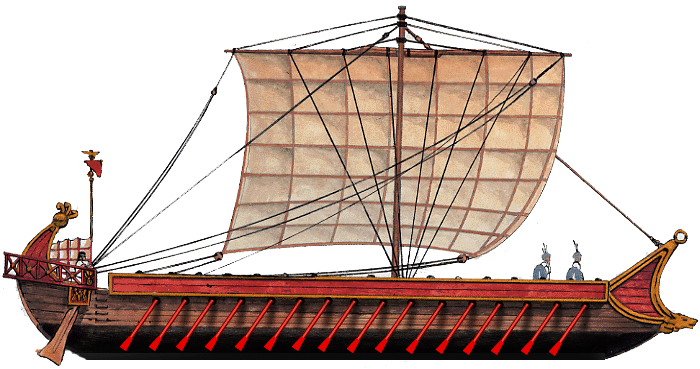
Actuarius of about 200 BC, second punic war, from a bas-relief of the Vatican (late empire). Note the decorative spur.
One of the first ships of the republic, a light galley of moner type (or Monoremi, a single row of oars), here of 24 rowers, used for dispatching with larger units. From the Greek typology, there are the Cisocontores (20 rowers, 10 per side), and the Triacontores (30 rowers, 15 per board), and all the intermediate declensions. On the other hand, we do not know the terms used to designate this type of Galera in Latin. It probably did not have a specific term other than that in Greek, like the Pentaconteres. The Actuariae were therefore light vessels (but never owned less than 18 rowers) and could easily be hauled on the shore. The term is repeatedly found in writings “navis actuaria”, but also designating a light troop transport ship, such as those operating during the Second Roman Civil War.
In this case, it was a relatively light cargo vessel with more rowers than usual. Faster than the enormous Onerariae, and destined for coastal shipping or short routes, these vessels approached (or derived from) the Akatos (Acatus) and Aphraktos Greeks (undecked ships). Very small units (less than 10 rowers per rowing) were also sometimes embarked on the octaves or decades of flags, for the purpose of connecting to land or other ships, such as Antoine to Actium, where he left battle. This ship was called Scapha, and can be likened to the Yawls of the later sail ships.
There were, however, also very large monuments (40 meters and over) whose ten-meter-long oars were manoeuvred by two standing rowers, who walked on the secondary deck (the upper deck was reserved for soldiers, Food and water supplies. These were not Actuariae but evolved liburnae, which gradually replaced the Actuarias.
About 100 to 50 av. J.C., one begins to see under the influence of the Pirates (Hemoliae) ships of the wider monoremis, to two-1/2 rowers by rowing. From then on, the multiple swimming, which became in the Middle Ages from triple to sextuple, made the happiness of the great merchant empires, and relegated to the distant past Cisoconter, triconter and Actuariae.
Liburna
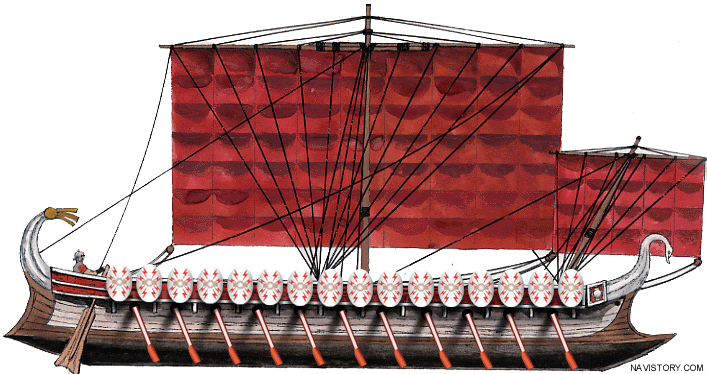
A Liburna of the imperial age (150 AD), carrying a consul (hence the red sails, this very expensive color being only exceptionally used). The lines are massive, and the bow prominently visible. This ship was far enough away from the original liburnae of the pirates…
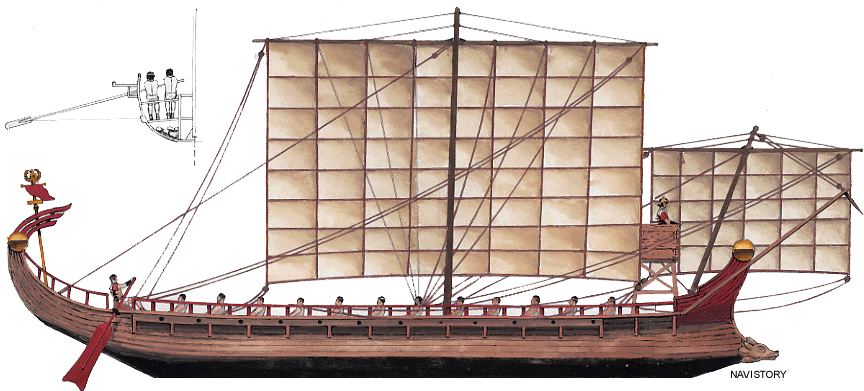
Liburna of Agrippa at the Battle of Actium in 31 BC. These encircled mastodons of the fleet of Marc Antoine and Cleopatra. Note the Roman additions: Archer (or command) tower at the front, wide open bridge (for two rowers) and “combat” lateral bridge and high corvus.
The Liburne (or Liburnica) is a famous ship, originating from the Liburnian pirates, because light craft, but unlike the frail Lembi, the Liburne was decked and possessed a sail, but above all, their width allowed them to possess oars handled by two Rowing machines. The Liburnians are an Illyrian tribe, operating on the Adriatic. It was in this way that the pragmatic Romans were inspired to create their own “Liburnae”. These ships played a leading role during the famous Battle of Actium in 31 BC. JC., Twice as numerous as the Romano-Egyptian ships they were fighting, separated the fleet from the fleet (the Marc-Antoine Decree) framed by its “lieutenants”, large units (probably “12”,”14″,”16″ and other Macedonian Leviathans), who, faithful to the old tactics of the Diekplous, began to pierce the enemy’s fleet and then to surround it behind. Much more manoeuvring, the light Liburnae quickly retreated on these ships, surrounded them from all sides before crows and ladders decided the fight with infantry assaulting and taking wooden fortresses at sea one by one.
Oneraria
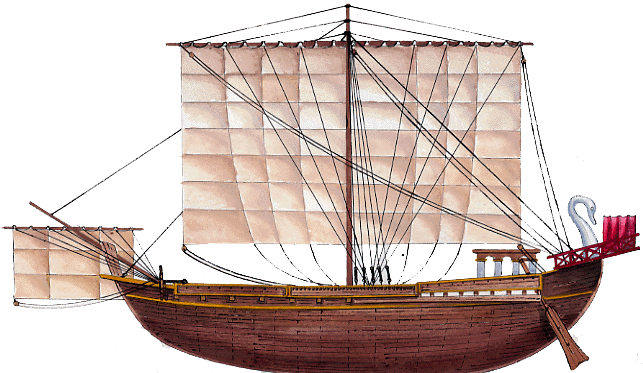
Standard freighter of the Roman merchant fleet, the Oneraria inspired the Corbita, much more massive
In some respects, antiquity still surprises us by certain aspects of a great modernity. For example, it is generally believed that in the maritime field, container ships date from the 1950s. However, the concept of boarding food of all kinds, liquid and solid in identical terracotta jars, standardized to the extreme, is indeed a very old practice, born of the practice of the Phoenicians, taken over by the Greeks , Then the Romans. Certainly an amphora is more modest than a modern container, but still well suited to storage in the frail merchant ships of the time.
The Oneraria was signalled well before the imperial era as the standard “cargo” Roman, it is even in some respects a generic term that intersects sub-variants, like Corbita, cargo of heavy wheat. These heavy-tonnage ships, capable of carrying more than 3000 amphorae, originated from the Greek cataphract cargo vessels which ensured trade between the Hellenistic empires in the Mediterranean basin. They were distinguished by Roman characteristics, such as the abandonment of the ladder at the rear and a strong draft, revealing modern deep-sea ports with jetties, a quarter-deck Terrace often accompanied by an awning, a bridge superstructure, a figure of gooseneck stern.
They were also massive vessels, sometimes double-decked (two superposed bridges), inevitably endowed with a bowsprit for manoeuvring, and a mainsail sufficiently effective to dispense with any other means of locomotion on Well-known trains, but not only specifically in coasting: Their solid oak hull allowed them to “rub” themselves on the links in the open sea, the locating being done, as always at night, by the stars. With the imperial era, Romans had access to the great forests of Gaul and Germany, and disposed of massive lumber of quality to build larger freighters. An Imperial Oneraria had to measure 35 meters for almost 10 of width. Her crew was reduced to 10 men at most, versatile.
Corbita
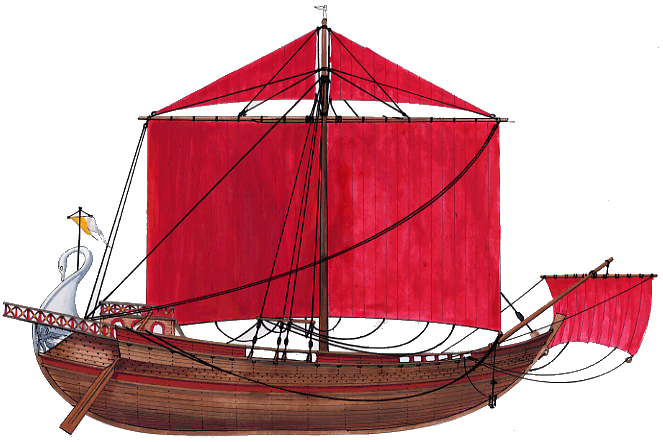
The Roman cargo par excellence, was a ship of great size, drawing water and tonnage.
If the documentation does not abound more for the Roman Cargoes than for the other units, this type of ship is better known than the trireme because of the enormity of its cargo, responsible for its shipwreck, unlike the galleys of war, Unsinkable. Greek and Roman cargo ships indeed constellate the bottom of the Mediterranean, under heaps of amphorae very well preserved. Although the extreme antiquity of these wrecks does not facilitate the task of the archaeologist divers due to the dilapidated state of the wooden structure, one can always complete the basic patterns by cross-checking them with bas-reliefs and frescoes found during centuries. The “Corbita” seemed to be a derivative of the Phoenician freighter, the Gaoul, characterized by a swan in figure of stern and a gallery. The first had a sailboat stitched, with an interrupted rail to facilitate loading.
The last, Romans, presented the culmination, with a very large shell. To facilitate his maneuver he has a sail called “artemon”, ancestor of trinquet de beaupré (). The mainsail is generally surmounted by a very recognizable triangular sail of arrow, the Supparum, generally red. The biggest of them were Onerariae, they were real “monsters” for the time, more than 55 meters long by 13 of the keel to the Tillac () and 14 wide, able to carry until 2000 Tons (the equivalent of 40,000 amphoras!) In general of wheat from Sicily. These onerariae were generally grouped in convoy and protected by the fleet in order to guard against any pirate attack. These Roman cargo ships were also supposed to carry up to 400 passengers under Spartan conditions. Having no place for possible rowers, the navigation of these freighters returning from Alexandria or Sicily was very slow and they practised coasting as far as Ostia.
Ponto
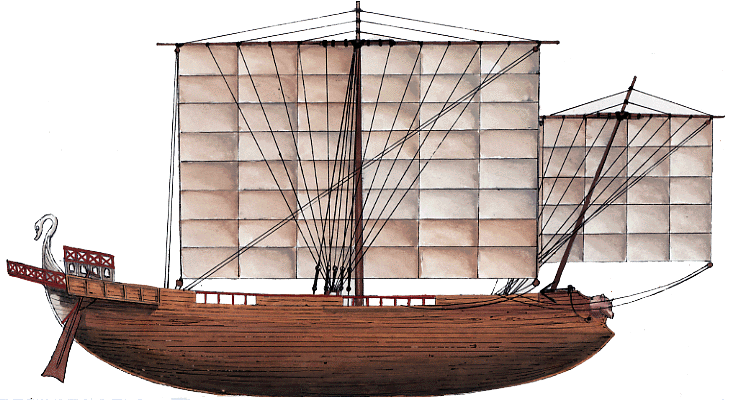
Heavy Roman cargo, the Ponto had some own characteristics, like the spur and the figurehead.
Although the Ponto was also described as a flat-bottomed craft, a sort of very common raft which served to join two shores with a system of ropes and pulleys, a ferry in short, the other “Ponto”, of “Pont “, Was a fairly massive freighter which was distinguished from the oneraria by a rostrum and often a figure of added prow. The Ponto had in addition to a rostrum of protection against collisions from the front, two masts with sails of large dimension (no paddle was embarked, the Ponto walked only with the force of the wind), the bowsprit Being more than a mere boost of maneuvering. For the rest, this cargo had the same characteristics as the classic Roman cargo, its name probably coming from the fact that it was bridged, but possibly also with a flatter bottom to go up the rivers. As the decoration was very sober, we found the eternal figure of stern in swan neck but this time a figure of prow evoking a animal more rough, in connection with the rostrum, such a bull, a goat or even a wild boar…
Carabus

Part of the Archaic Roman Boats (1200-300 BC)
The Carabus here is typical of the boats of the late Neolithic, a mixture of ancestral techniques peculiar to the peoples of Europe but also of Asia (craft in skin of the basin of Mesopotamia) related to the Coracle Gaulois, craft going back to an even more age And it is difficult to date (it is possible that Neolithic tribes crossed the Atlantic on coracles during the ice age). But the Italian peasants and fishermen still used them around 300 BC. JC .. The Carabus is a sort of large wicker basket in the shape of a conch, waterproofed by skins sewn on the outside. The seams were themselves coated with grease and the hull was turned over and dried for a long time in the sun. These light boats were used on lakes, rivers, and cabotage in calm weather.
Cymba

Roman fishing boats (1000 BC – 9 AD). The Cymba was the classic fishing boat from the archaic period, up to the Roman imperial era. Not veiled, it was handled with two oars and a lateral rowing, but also with the gaffe. Constructed of wood, called “concava”, it was built in a traditional way, with keel, ribs, planking, and naturally unbridged. The copy here represented is taken from a mosaic of the 2nd century at the museum of Sousse in Morocco.
Actuariolum

Actuariolum (200 BC). Taken from a bas-relief of the Vatican (late empire).
The Actuariolum was a pure passengers boat, not fit for war or trade. A small unbridged boat which was specified to have never more than eighteen rowers as opposed to the “great” Actuaria. Actuariolum was the diminutive of Actuaria. It was also not veiled in principle, although weather permitting, the erection of a mast bearing a small sail easy to stir. One of them is mentioned for having transported Cicero, and possessed two rows of five rowers. Most of these boats were therefore simple boats, which could be carried if necessary on a large ship, and also practiced river navigation and on lakes.
Cercurus

A Cercurus of Umbria, (200 BC), from a description on a Roman bas-relief. The rear part is clear, left free for loading, which continues in the hold, including under the rowers. This vessel is rather heavy and slow, manned by only one man per oar. The figurehead is a purely protective “rostrum”. It was able to go up large rivers and practiced coastal navigation as well.
The Cercurus, also known as Kerkouros or Kerkyra in Greek, was actually of Cyprus origin, originating from the commercial city-state of Corcyra. It was a cargo ship operated solely by rowing, and it seems characterized by an absence of rowers at the rear, a large space left for loading, probably amphorae and ballots also stored if necessary in the hold. There is little information on this ship, very few mentions and even less descriptions. The Kerkouros was also the name given to a fast Phoenician ship, which inspired the Cypriots, then the Greeks (Kerkyra). As a result, the Kerkouros dates back to 1400 BC. JC. It is undoubtedly the first merchant galley, a genre brought to its paroxysm by the Venetians and Genoese in the Middle Ages. Moreover, the term is also at the origin of Carrica, become in French “Caraque”, english carrack or “Karrick” the famous universal heavy ship of the XIII-XVIe centuries. The above Cercurus is a double-headed ship (like some liburnae) taken from a bronze medal plate.

 Latest Facebook Entry -
Latest Facebook Entry -  X(Tweeter) Naval Encyclopedia's deck archive
X(Tweeter) Naval Encyclopedia's deck archive Instagram (@navalencyc)
Instagram (@navalencyc)





 French Navy
French Navy Royal Navy
Royal Navy Russian Navy
Russian Navy Armada Espanola
Armada Espanola Austrian Navy
Austrian Navy K.u.K. Kriegsmarine
K.u.K. Kriegsmarine Dansk Marine
Dansk Marine Nautiko Hellenon
Nautiko Hellenon Koninklije Marine 1870
Koninklije Marine 1870 Marinha do Brasil
Marinha do Brasil Osmanlı Donanması
Osmanlı Donanması Marina Do Peru
Marina Do Peru Marinha do Portugal
Marinha do Portugal Regia Marina 1870
Regia Marina 1870 Nihhon Kaigun 1870
Nihhon Kaigun 1870 Preußische Marine 1870
Preußische Marine 1870 Russkiy Flot 1870
Russkiy Flot 1870 Svenska marinen
Svenska marinen Søværnet
Søværnet Union Navy
Union Navy Confederate Navy
Confederate Navy Armada de Argentina
Armada de Argentina Imperial Chinese Navy
Imperial Chinese Navy Marinha do Portugal
Marinha do Portugal Mexico
Mexico Kaiserliche Marine
Kaiserliche Marine 1898 US Navy
1898 US Navy Sovietskiy Flot
Sovietskiy Flot Royal Canadian Navy
Royal Canadian Navy Royal Australian Navy
Royal Australian Navy RNZN Fleet
RNZN Fleet Chinese Navy 1937
Chinese Navy 1937 Kriegsmarine
Kriegsmarine Chilean Navy
Chilean Navy Danish Navy
Danish Navy Finnish Navy
Finnish Navy Hellenic Navy
Hellenic Navy Polish Navy
Polish Navy Romanian Navy
Romanian Navy Turkish Navy
Turkish Navy Royal Yugoslav Navy
Royal Yugoslav Navy Royal Thai Navy
Royal Thai Navy Minor Navies
Minor Navies Albania
Albania Austria
Austria Belgium
Belgium Columbia
Columbia Costa Rica
Costa Rica Cuba
Cuba Czechoslovakia
Czechoslovakia Dominican Republic
Dominican Republic Haiti
Haiti Hungary
Hungary Honduras
Honduras Estonia
Estonia Iceland
Iceland Eire
Eire Equador
Equador Iran
Iran Iraq
Iraq Latvia
Latvia Liberia
Liberia Lithuania
Lithuania Mandchukuo
Mandchukuo Morocco
Morocco Nicaragua
Nicaragua Persia
Persia San Salvador
San Salvador Sarawak
Sarawak Uruguay
Uruguay Venezuela
Venezuela Zanzibar
Zanzibar Warsaw Pact Navies
Warsaw Pact Navies Bulgaria
Bulgaria Hungary
Hungary

 Bundesmarine
Bundesmarine Dutch Navy
Dutch Navy Hellenic Navy
Hellenic Navy Marina Militare
Marina Militare Yugoslav Navy
Yugoslav Navy Chinese Navy
Chinese Navy Indian Navy
Indian Navy Indonesian Navy
Indonesian Navy JMSDF
JMSDF North Korean Navy
North Korean Navy Pakistani Navy
Pakistani Navy Philippines Navy
Philippines Navy ROKN
ROKN Rep. of Singapore Navy
Rep. of Singapore Navy Taiwanese Navy
Taiwanese Navy IDF Navy
IDF Navy Saudi Navy
Saudi Navy Royal New Zealand Navy
Royal New Zealand Navy Egyptian Navy
Egyptian Navy South African Navy
South African Navy






























 Ukrainian Navy
Ukrainian Navy dbodesign
dbodesign